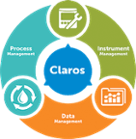-
Products
-
Lab Instruments
Titration Systems Other Instruments
-
Lab Meters and Probes
Calibration Standards Other Meters and Probes
- Chemistries, Reagents, and Standards
-
Online Analyzers
EZ Series Analysers
- Iron
- Aluminium
- Manganese
- Phosphate
- Chloride
- Cyanide
- Fluoride
- Sulphate
- Sulphide
- Arsenic
- Chromium
- Copper
- Nickel
- Zinc
- Ammonium
- Total Nitrogen
- Phenol
- Volatile Fatty Acids
- Alkalinity
- ATP
- Hardness
- Toxicity
- Sample Preconditioning
- Boron
- Colour
- Nitrate
- Nitrite
- Silica
- Hydrogen Peroxide
- EZ Series Reagents
- EZ Series Accessories
- EZ sc Series Inorganics
- EZ sc Series Metals
- EZ sc Series Nutrients
- Flow and Collections
-
Online Sensors and Controllers
Conductivity Sensors
- 3400 Analogue Contacting
- 3400 Digital Contacting
- 3700 Analogue Inductive
- 3700 Digital Inductive
- 9523 Cation Conductivity
- Multiparameter Online Panels
- Claros Water Intelligence System
- Test Kits & Strips
-
Microbiology
Prepared Media
- BARTS
- Liquid MPN
- MUG Tube
- Membrane Filtration
- Paddle Testers
- Presence-Absence
- Total Count Media
- Yeast and Mold
Labware- Accessories
- Funnels, Pumps & Manifolds
- Microbiology Filters
- Petri Dishes & Accessories
- Sampling Bags
- Vials, Tubes, Bottles & Racks
-
Lab Equipment and Supply
ApparatusInstruments Glassware/PlasticwareGeneral Lab Consumables Safety Equipment Books and Reference Material
- Samplers
- Industrial UV
- Electrochemistry
-
Lab Instruments
- Parameters
- Industries
- Support
- Service
- e-Shop
- Brands
RTC-N Software Module
- Overview
- Details
- Downloads
- Video
- Similar Products
Product #:
LXZ519
Unit Price
Contact Hach
Do you want to stabilize your effluent ammonium and save energy at the same time?
Numerous factors affect nitrification in plug flow basins and step-feed (cascade) plants: temperature, alkalinity, dissolved oxygen concentration, hydraulic retention time, amount of nitrifying bacteria in the MLSS, TSS and NH4-N. To maximize the efficiency of this process, you could install expensive blowers and diffusers, but without insight into each parameter—particularly oxygen transfer efficiency—there’s no guarantee that high-capital improvements will provide a return on investment.
For a considerably smaller expense, deploy instrumentation to monitor treatment status and operating conditions, then pair it with software that helps manage DO using variable setpoints. Did you know that oxygen transfer efficiency actually drops as the actual DO increases toward saturation? That means that, at times, the same amount of oxygen can be transferred in your MLSS at a lower airflow with a lower DO. Hach’s RTC-N Software calculates and adjusts DO concentration in response to your plant’s real-time ammonium load and your desired effluent ammonium setpoint. In tandem with your existing blowers, RTC-N delivers ideal dissolved oxygen levels for each of the ASP aerated zones as the ammonium load travels along the lanes, concentrating air to the zones of greatest need and using energy only when required to keep levels within range.
Claros Process Management solutions for nitrification/denitrification like RTC-N are designed to make the most of your plant’s real-world conditions by transforming every uncertainty into an opportunity for measurement, responsive action, and savings.
- Stable NH₄-N effluent
- Improved denitrification and greater capacity
- Typical energy savings of up to 25%
- Stronger performance
- Validated proof control





 Recurring Orders
Recurring Orders 





